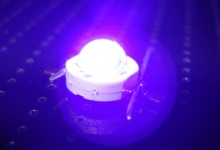Since the Minamata Convention on Mercury has been passed, the replacement of mercury lamps with more efficient UV LED lamps has been widely discussed. Without doubt the application of LED UV lamps can be expected to rise sharply due to the banning of mercury lamps by the year 2021.
Compared to mercury lamps, UV LED offers several advantages. Efficiency, reliability, a long life span and savings on energy consumption are natural benefits of LED lamps, combined with a much better environmental impact of the LED compared to poisonous mercury. Last but not least LED UV is more flexibly applicable in various lighting fixtures and offers a much broader range of application for lighting manufactures.
Following these considerations, notable LED providers such as Nichia, Osram, Lextar and others have recently strongly focused on the development of UV LED, particularly UV-C LED for the sterilization and purification of water. Next to UV-C LED, another UV wavelength are available with UV-A LED, mainly applied in the area of curing whilst the third type, UV-B LED is applied in the medical area such as for skin treatment.
Looking at the different types of UV LED wavelengths, without doubt UV-C LED is in the main focus of all LED providers which currently focus on the development of UV technology. Next to water sterilization and purification, UV-C LED may also find its application in areas such as food sterilization and preservation. UV-C LED products are expected to find their application in both, private and commercial/industrial areas.
Undoubtedly the UV-C LED industry will see a rapid growth within the next years and products are expected to hit markets latest by 2021, replacing the poisonous mercury lamps.gm.


